Computational Chemistry
QM: elucidation of reaction mechanisms. QM/MM: unraveling enzymatic mechanisms. Computational Bilogical Chemistry: Docking. Molecular dynamics simulations. QM/MM/MD. Metadynamics. Topological calculations
The Group of Biological and Computational Chemistry dedicate greatt part of is activity to the computational chemistry of any kind, mainly, organic chemistry and biological chemistry. The group has its own resources consisting grosso modo in: 8 workstations with a total of 24 GPUs, 200 EPYC processors and more than 500 TB in disk from which 12 TB are in M.2 disks dedicated to scratch. In addition as a member of the Institute of Biocomputation and Physics of Complex Systems we have full access to the clusters of the Institute with more than 6000 processors.
 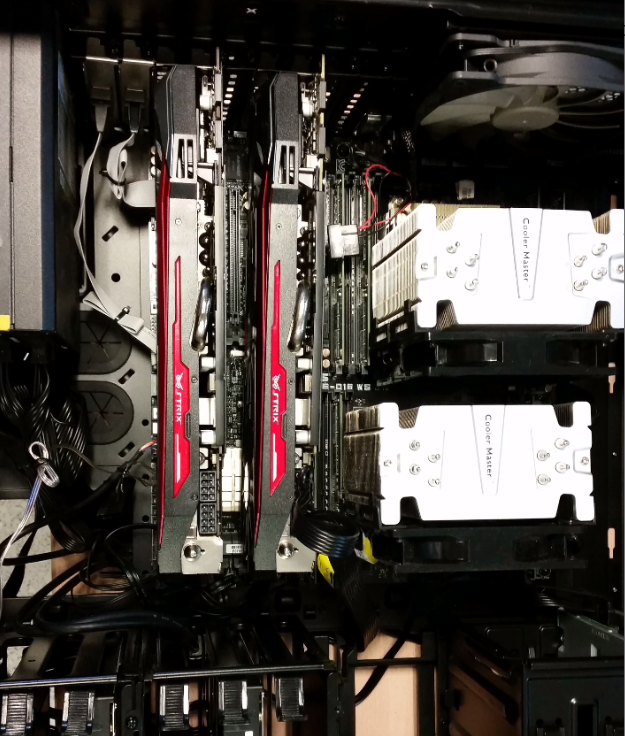 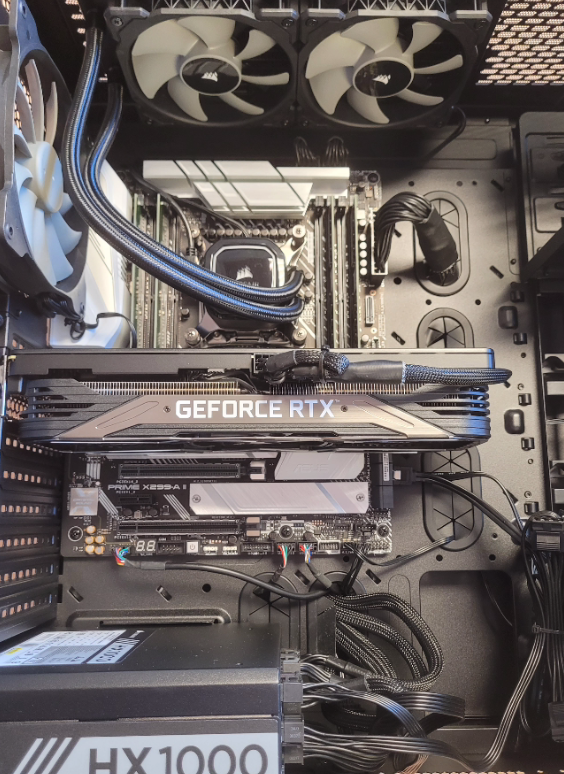
|
|
Laboratory of Asymmetric Synthesis
Enantioselective Metal Catalysis - Asymmetric Organocatalysisis - Stereoselective Processes
The Group of Biological and Computational Chemistry is housed in newly refurnished laboratory space with individual fume cupboards, dedicated writting-up areas (both inside and outside the lab space) equipped with computers connected to internet and a suite of instruments rooms.
 
Laboratory of Synthesis
The laboratory is well-equipped with routine equipment for organic synthesis. These equipment include magnetical stirrers (heating and magnetic), water-free rotatory evaporators (equipped with membrane pumps, vacuum controllers and chiller), vacuum pumps, dessicators, mechanical stirrers, motorized syrynges, coolers for low-temperature reactions (up to 173 K) and all the necessary glassware. The carrussel systems allow multirreactions for preliminary assays at temperatures ranging 273-173K.
|
|
Laboratory of Analysis and Purification - Radial Chromatography - MPLC - HPLC
Purification of materials are made at different levels in our laboratory of analysis and purification. We use rapid and efficient radial chromatography for preparative samples to be ready in less than thirty minutes. For large amounts and/or separation of close-running isomers we have the MPLC system. Finally, a complete analysis of our products and obtention of extremely pure samples we utilize our diverse-oriented HPLC systems.
(go top)
Preparative Centrifugally-accelerated Radial Thin Layer Chromatography
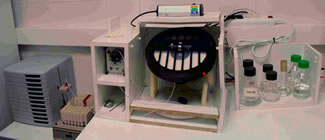
The Chromatotron |
With the Chromatotron we can purify in 15 minutes and spending no more than 300 mL of eluent up to 1.0 gram of sample. The system is extremely efficient and rather useful for easily separable mixtures or purification of starting materials. The solvent is pumped by an special teflon-solvent-resistant pump and the eluent can be collected in a small automatic fraction collector. The evaporation of fractions can be done in the same laboratory by using the rotatory evaporation system installed close to the chromatographic installation. |
Medium Pressure Liquid Chromatography (MPLC)
The medium-pressure system is based on a Büchi B-800 pump capable of delivering up to 160 mL/min with a maximum pressure of 40 bar. Glass-safe columns of Buchi can be filled with silica of 25-35 microns to achieve an excellent performance in multigram-scale separation of isomers. Detection is carried out by a dual band UV detector which is controlled by a computer system based on the Millenium software of Waters Inc. The system is completed with a highly versatile fraction collector that gives us an autonomy of more than 3 hours for standard separations. We have also used the MPLC system for purifying natural compounds using different refills including ion-exchange resins, active carbon and microcrystalline cellulose. In addition we have 3 Combiflash for purifying samples from 0.1 g to 40 g under MPLC conditions
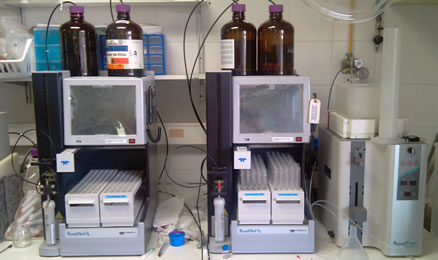 
Combiflash Systemsoo oooaaooooooooooooooooooooo MPLC systemoooooooooooooooooooooooFT-IRoo
(go top)
|
MPLC system
|
High-Performance Liquid Chromatography (HPLC)
|
We have in our laboratory five full HPLC systems for general use of our researchers.
HPLC 1 - Waters Alliance for analytical use (flow: 0.001-6.0 mL/min)
HPLC 2 - Waters Acquity for analytical use (flow: 0.001-1.0 mL/min)
HPLC 3 - Waters isocratic for analytical and semipreparative use (flow: 0.01-10 mL/min)
HPLC 4 - Waters quaternary for semipreparative use (flow: 0.1-25 mL/min)
HPLC 5 - Waters isocratic for semipreparative use (flow: 0.1-25 mL/min)
HPLCs 1 and 4 are dedicated to normal fase HPLCs 2 and 5 are dedicated to reverse phase HPLC 3 is versatile for both uses All the systems are computer operated, based on Millenium software to allow for better data collection and storage. These HPLC systems allow us to perform a wide range of procedures, including new method development, analysis of reaction mixtures and larger scale separation of products. We have also a large number of normal and reverse phase columns in both analytical and preparative sizes. We have chiral columns (IA, IB, IC, OD-H, OD-J, etc.) for enantiomer analysis, too. Depending on the system used, detection is accomplished using Ultraviolet Absorbtion (dual band and/or PDA detector) or Light Scattering (LSD). Typical amounts for analysis are 0.1-1 mg, where as semi-preparative methods can handle from 10-200 mg depending on the quality of separation.
 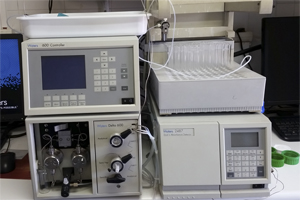 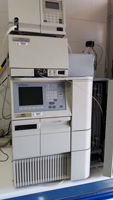
|
|
|
Lyophilizer
 Lyophilizer
Lyophilizer |
We have in our laboratory a fully implemented lyophilization system
The lyophilization process allows to obtain extremely pure compounds since no degradation is observerd from the first freeze step of the sample. After sublimation of the solvent (water) crystalline compounds are obtained. This system is particularly useful for us to eliminate solvent from semipreparative HPLC fractions. Thus, after purification of the products by HPLC it is possible to eliminate the solvent (water) without any degradation of the product to be obtained. The lyophilizer is equipped with high-vacuum pumps that remove the non-condensable gases.
|
(go top)
s |
|
Redox Systems (Hydrogenation & Ozonization)
We have in our laboratory two hydrogenation systems
oooLow pressure Parr hydrogenation apparatus (up to 5 atm)
oooMedium pressure reactor (up to 300 atm)
The particular way of stirring of the Parr apparatus favours
the interaction of the hydrogen in the surface of the solvent thus facilitating the hydrogenation reaction. The medium pressure reactor can also be heated with the proper accesory or even with a sandbath
Also a Ozonizerr is available for oxidation reactions
|
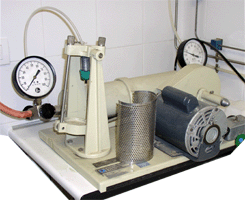 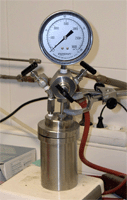 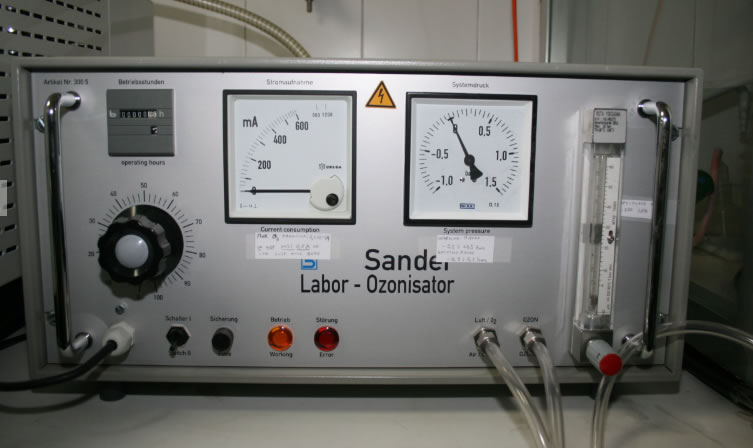
Parr hydrogenation apparatusoo oooaHigh-pressure oooooOzonizeroo
|
|
| |
|
| Common Facilities
We are a part of the Unit of Glcobiology of the Institute of Biocomputation and Physics of Complex Systems (BIFI. University of Zaragoza) as well as of the Department of Synthesis and Structure of Biomolecules integrated in the Institute of Chemical Synthesis and Homogenous Catalysis (ISQCH. University of Zaragoza-CSIC). We have a complete access to the facilities that are at disposition of all members of the above mentioned institutions. You can check these facilities at the folllowing links:
University of Zaragoza Services
BIFI Services
ISQCH Services
|
|
| |
|














